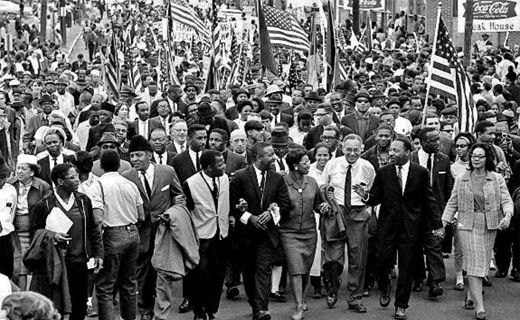
I have heard – and rightfully so – the Rev. Martin Luther King Jr.’s name and words referenced in the wake of the murder of Freddie Gray and subsequent events in Baltimore.
In this spirit, it would seem worthwhile at this moment to study in some detail how MLK and his coworkers drew the clergy and trade unions into the civil rights movement of their time; how they transformed an initiative that was local in its origins into a movement that was national (even international) in scope; how they reached and changed people, especially white people in the South as well as the North, who were considered unreachable and unchangeable by many; how they allied themselves, despite many pressures from within the movement not to do so, with allies that were unreliable and not in the struggle all the way; how they developed a legislative, electoral, and political dimension to their activity to complement their grassroots initiatives; how they resisted pressures to narrow down the movement to only those who were fully on board and disposed to the most militant forms of action; how they pressed their vision, agenda, and tactics, while at the same time maintaining unity and cooperation among the diverse actors in the civil rights coalition; how they interacted with the Kennedy and then Johnson administrations, not to mention Congress, at each stage of the civil rights struggle; how they created a range of entry points to allow people with different levels of commitment and understanding more than one way to participate in the struggle against racism.
In short, how they (with great courage, creativity, and confidence in the American people) scaled up and out their movement to the point where it became, I would argue, the most notable and successful movement (it brought down a century old system of brutal and humiliating racist oppression and exploitation) of a mass, progressive, and radically democratic character of the 20th century.
While nonviolent mass civil disobedience was at the core of their vision and strategy (and, I would argue, should be at the core of the current struggles for racial justice and justice generally), much else can be learned from MLK and the movement he ingeniously led that would well serve today’s emerging movements for racial justice (and justice generally).
Photo: Rev. Dr. Martin Luther King Jr. led the historic Selma to Montgomery march which united civil rights, labor, and a broad coalition of organizations. | archive photo

MOST POPULAR TODAY


Zionist organizations leading campaign to stop ceasefire resolutions in D.C. area

High Court essentially bans demonstrations, freedom of assembly in Deep South

Afghanistan’s socialist years: The promising future killed off by U.S. imperialism

Communist Karol Cariola elected president of Chile’s legislature






Comments